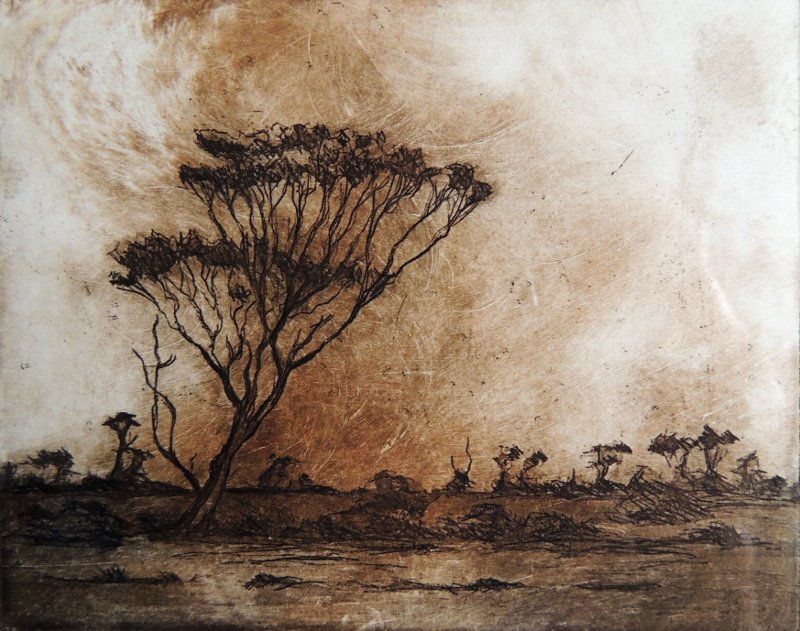Living Data
Science Art & Talks
The experiential process of observation and reflection is key to art and science
and is an essential component in understanding interdependence
of all species and ecosystems, terrestrial and aquatic.
Paul Fletcher Animator
Science Art & Talks
Living Data Program for the 2013 Ultimo Science Festival, Sydney, September 12-21.
Nature Works Etchings by Andrea Leigh
High temperature extremes are predicted to increase in both intensity and frequency.
Science is practised to understand how the living world works and how it can be sustained.
Etchings are made that express a sense of being part of the changing living world.

Drought III 2013
Etching by Andrea Leigh
The living world stops me in my tracks - making art is my way of trying to articulate the wonder I feel every time my feet hit the soil.
Natural forms and the processes that shape them inspire my work as a scientist, educator and artist. Since a childhood spent surrounded by eucalypt bushland, a sense of wonder and curiosity have inspired me to understand how nature works. By drawing and printing I reconnect to my experience of being in the living world, while doing science connects me to a global community of people who share my desire to know about the natural environment and care about sustaining it.
I am a plant ecologist in the School of the Environment at the University of Technology, Sydney, where I research and teach. I am fascinated by the relationship between plant structure and function and compelled to understand particularly how plants survive extreme heat stress. High temperature extremes are predicted to increase in both intensity and frequency in the future and we don't yet know how plants will adapt to cope, nor if all of them will. I focus on desert and semi-arid environments, where organisms often live on the edge of biological tolerance, something that fascinates me. To support theoretical and laboratory predictions, I am a strong believer in field research, which more closely represents how organisms respond to stress in their natural environment.
I took an unconventional road to becoming a science academic at UTS: a BA (Visual) was followed by several years traveling in Africa and Europe, then returning to university as a mature age student to do a BSc (Hons) and PhD in Ecology, Evolution and Genetics. Although apparently contrasting educational pathways, I see science and art as being entirely complementary, one informing the other on many levels. As a tertiary educator, I love nothing more than bringing students, many of whom have never been outside the city, into the environment to learn about it by experiencing it. The aesthetic beauty and physical presence of the landscape pervade the senses and, for many students, provide the entry point for learning about the environment. The most rewarding experience for me is to hear a student say: now I understand.
Andrea Leigh 2013
Notes for exhibition designers:
"Nullabor Drought"
240H x 265W
(etching & monoprint, framed)
Untitled (Cockroach)
250H x 270W
(etching & watercolour, framed)
"In the Boxes I"
280H x 330W
(hand-wiped etching, framed)
"In the Boxes II"
280H x 330W
(hand-wiped etching, framed)
"Pohutukawa"
265H x 320W
(etching & watercolour, framed)
To evaluate how reciprocity works in Living Data and how our program could be improved, I ask contributors,
What do you most value about our work?
What have you contributed?
How have you benefited?
How could our program be improved?
Andy Leigh, Scientist, University of Technology, Sydney
What do you most value about our work?
I am glad that artists want to talk with scientists and that they are
interested in what we do - as art speaks a language that often is more
broadly understood than the dense, jargon-rich language of science, my hope
is that this work will contribute to improving the dialogue between
scientists and the wider community, particularly with respect to something
as urgent as climate change.
What have you contributed?
I contributed both as a scientist and an artist. As a scientist, I spoke
on how we teach environmental science to undergraduate students in ways
that draw on the creative senses. As an artist, I contributed several of
my etchings depicting my response to aspects of the natural world and how
we change it.
How have you benefited?
I met some great people, both scientists and artists. As a practicing
scientist, it was particularly interesting to speak with artists and learn
about how they perceive the same world I do but from a different
perspective. This has had the effect of challenging my assumptions about
how science is perceived in the community and how it might be communicated.Living Data has increased the exposure of my research, generated lots of interest and positive buzz, and opened up the possibility for developing future collaborations and funding opportunities.
How could the Living Data program be improved?











